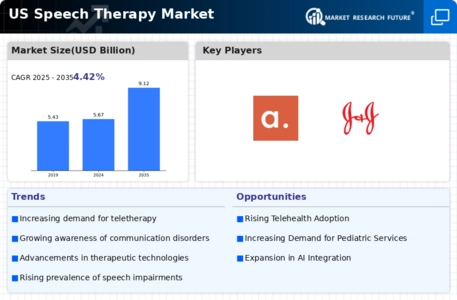Aging Population
The demographic shift towards an aging population in the United States is likely to have a profound impact on the US Speech Therapy Market. As the population ages, the prevalence of age-related speech and language disorders, such as aphasia and dysarthria, is expected to rise. Data indicates that by 2030, nearly 20% of the US population will be over the age of 65, creating a substantial demand for speech therapy services tailored to this demographic. This trend suggests that healthcare providers and therapists may need to adapt their services to meet the unique needs of older adults, thereby driving growth in the US Speech Therapy Market. The integration of specialized programs for seniors could further enhance service delivery and patient outcomes.
Insurance Coverage Expansion
The expansion of insurance coverage for speech therapy services is a notable driver for the US Speech Therapy Market. As more insurance providers recognize the necessity of speech therapy for various conditions, including developmental delays and post-stroke rehabilitation, access to services is improving. Recent legislative changes have mandated that certain speech therapy services be covered under health insurance plans, which may lead to increased utilization of these services. This trend suggests that financial barriers to accessing therapy are diminishing, thereby encouraging more individuals to seek treatment. Consequently, the US Speech Therapy Market is expected to benefit from this expansion in coverage, as more patients are likely to pursue therapy options that were previously unaffordable.
Focus on Pediatric Speech Therapy
The emphasis on pediatric speech therapy is becoming increasingly pronounced within the US Speech Therapy Market. Early intervention is critical for children with speech and language delays, and parents are becoming more proactive in seeking therapy services. Recent statistics suggest that early intervention can significantly improve communication skills, leading to better academic and social outcomes for children. This focus on pediatric therapy not only drives demand for specialized services but also encourages the development of targeted programs and resources for children. As awareness of the benefits of early speech therapy continues to grow, the US Speech Therapy Market is likely to experience sustained growth in this segment.
Technological Advancements in Therapy
The integration of advanced technology into speech therapy practices is emerging as a pivotal driver for the US Speech Therapy Market. Innovations such as teletherapy platforms, mobile applications, and artificial intelligence tools are transforming how therapy is delivered. These technologies not only enhance accessibility for patients but also improve the efficiency of therapy sessions. For instance, teletherapy has expanded access to services for individuals in remote areas, potentially increasing the overall patient base. As technology continues to evolve, it is likely that the US Speech Therapy Market will see a surge in demand for tech-enabled therapy solutions, which may lead to improved patient engagement and outcomes.
Increased Awareness of Speech Disorders
The rising awareness of speech disorders among the general population appears to be a significant driver for the US Speech Therapy Market. As more individuals recognize the importance of addressing speech and language issues, the demand for therapy services is likely to increase. According to recent data, approximately 1 in 12 children experience a speech or language disorder, which underscores the necessity for early intervention. This heightened awareness not only encourages parents to seek professional help but also promotes educational initiatives aimed at identifying speech-related challenges. Consequently, the US Speech Therapy Market is poised for growth as more individuals pursue therapy options to enhance communication skills and overall quality of life.













Leave a Comment